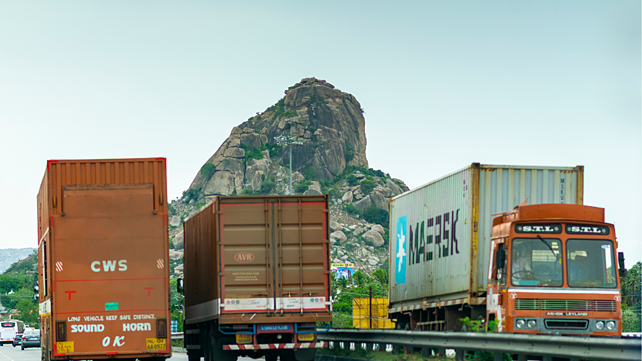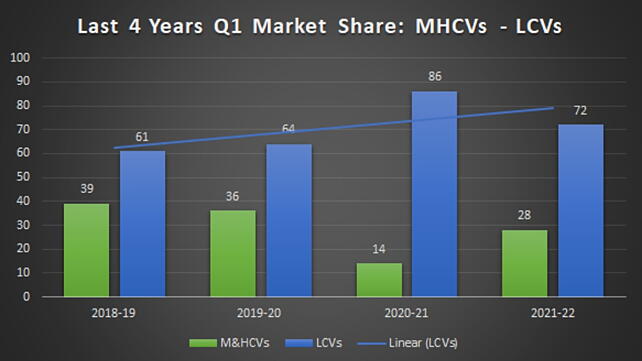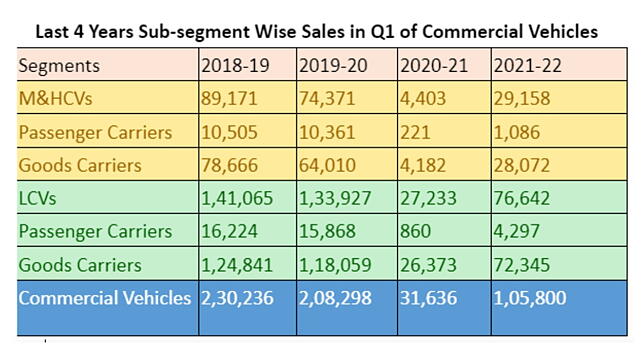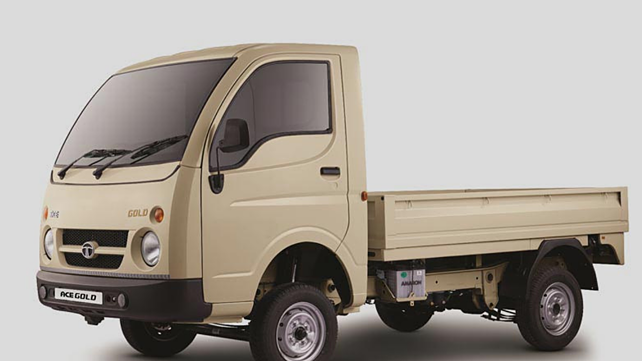
The commercial vehicle segment is undergoing a transformation as the demand for medium & heavy commercial vehicles (M&HCVs) is gradually tapering off because of the competitive railway tariffs and the high cost of their operations.
On the other end of the spectrum, light commercial vehicles (LCVs) are gaining momentum on the back of rising demand from the e-commerce sector. The LCV segment also benefits from the added advantages of lower maintenance and cost of operations due to the availability of alternate fuels like CNG.
According to data released by the Society of Indian Automobile Manufacturers (SIAM), LCVs have claimed 72% of the total commercial vehicle domestic sales in Q1 FY22. One can view this growth to have come from the pandemic-induced lockdowns, considering the increased demand for last-mile delivery. However, we can’t lose sight of the fact that the market share of LCVs has been steadily increasing even before the pre-pandemic period.

Consider this: the market share of LCVs rose from 61% in Q1 FY19 to 64% in Q1 FY20 and now to 72% in Q1FY22. We haven’t taken into consideration Q1 FY21 because of the total lockdown of 40 days due to the outbreak of the pandemic.
What led to the shift?
To analyse further, Mobility Outlook dug deep into the data and spoke to various industry stakeholders to understand what is leading to the demand shift of M&CHVs and LCVs, which makes up for bulk of the commercial vehicle segment in India.
Experts tracking the developments in the segment indicated that the shift started with axle-norms being implemented in mid-2018, which increased the loading capacity of trucks. At the same time, an e-way bill was introduced that promoted the hub and spoke model, which increased the demand of light commercial vehicles because of the local demand.
On the other hand, the roll out of BS-VI fuel norms in the country hiked the price of trucks by 20%, and that acted as a dampener to the replacement demand.
Shamsher Dewan, Vice President – Corporate Ratings, ICRA elucidated that the market share of LCVs is looking high because of the lower sales of M&HCV trucks and buses.
“Bus is the only segment that is badly hit ever since the pandemic happened, as the major demand for buses comes from school, colleges, state transport undertakings, staff carrier segment and tourism. All these segments are at standstill since last year,” he said.
SIAM data reveals that in Q1 FY22, the passenger carrier segment (buses) fell to 1,086 units from 10,505 units in the same quarter of FY19, a drop of 89.66%. Similarly, goods carriers of the M&HCV segment fell by 64.31%.

The impact of railways
Since the last one and half years, railway mode of transportation has become very competitive in terms of offering lower tariffs for short-haul distances of less than 1,000 km, Dewan added. Traditionally, railways were an option only for long-haul transportation beyond 1,000 km, but with recent relaxation in tariffs, railways have become an attracting option for businesses.
In September 2019, the government had announced various measures to attract business. Primarily, a waiver of 15% peak season surcharge on freight transport was announced along with a waiver of 5% supplementary charge on the use of mini rakes to help boost loading of smaller size cargo.
Apart from this, one of the other important decisions made was to charge haulage for 0-100 km slab for the total to and from movement, instead of charging for 0-50 km slab each way. This enables 35% cheaper per Twenty-Foot Equivalent (TEU) container for the complete round-trip.
Earlier, non-perishable items such as coal were transported via railways but now even steel, automobiles and perishable items such as fruits and vegetables are also getting transported by railways, said Bal Malkit Singh, Chairman Core Committee and Former President, All India Motor Transport Congress (AIMTC).
He added, “Railways are emerging as a big competition for long haul trucks. This is also the reason the demand for LCVs are increasing as local movement is rising. Goods move from field to railway yards and from the other destination it moves to shop.”
Rising LCV demand
While the demand for LCVs has been largely pushed by the e-commerce sector, the farm sector, which has been performing strongly since the last two to three years, contributes about 40-45% of LCV sales, added Dewan. Moreover, states like Delhi restricting entry of diesel trucks is also impacting sale locally.

Sachin Haritash, Founder, Mavyn and Director, Chetak Logistics also pointed out a shift happening in consumer behaviour. People are now buying everything online, which is translated to the logistics sector. Due to the rise in demand from e-commerce, there are a lot of requirements for last-mile connectivity vehicles. This is the reason sales of LCVs are rebounding faster, he reasoned.
Apart from the sectoral specific demand, LCVs also offer flexibility for fleet owners as LCVs come with alternate fuel options like CNG, which brings down the cost of operations and it is easy to maintain.
Market sentiment
With prices of diesel touching INR 90-100 per litre, the operational cost of logistics players has increased by up to 65%. Freight rates, on the contrary, haven't increased in the same proportion due to ample fleet availability.
This is creating pressure on fleet operators and many are defaulting on their loans. Be it big or small, no one is in a position to buy new vehicles or even replace the existing ones, said the promoter of a logistics provider operating in Mumbai, on the condition of anonymity.
He also pointed out that the level of defaults happening on repayment of loans on trucks will spoil the CIBIL score of the fleet companies, which will later tighten their financing prospects; making the situation worse as they would not be able to buy new trucks in future.
Sanskar Gupta, Promoter, Commercial Auto Sales, a Tata dealer pointed out the situation was improving in March, but started worsening in April and May with the onset of the second wave. Things are once again improving from last week, he said.
Transporters are either buying LCVs or multi-axle vehicles but there is very less demand of medium commercial vehicles, he said adding the price of diesel is acting as a major factor in their cost of operations.

Outlook
Industry experts are of the view that if vaccination drives increase rapidly and there is no third wave, commercial vehicles may rebound in the next two quarters as economic activity improves and invites government thrust towards infrastructure.
Dewan said, “If everything goes well, the demand for buses can see a revival in the last quarter of this fiscal year. Also, the replacement demand of trucks will also contribute to the overall sales of commercial vehicles.”
According to an ICRA study, the average life of M&HCV in India is 9.6 years now, which used to be 7.5-8 years a few years back. So, when the average life of M&HCVs crosses a threshold of 8-8.5 years, the replacement demand comes back and this is going to happen this year, argued Dewan.
Moreover, demand for construction segments such as tipper trucks will likely increase as infrastructure activity picks up because the government has started moving the pedal.
On a low base of FY21, ICRA expects 40-45% growth in the M&HCV segment in FY22. Similarly, 10-15% growth can be observed in LCV trucks and 30% for buses in the same period.
Company-Wise Performance Of CV Segment in Q1FY2022
| Domestic Sales - Q1FY2022 Vs Q1FY2021 | |||
| Manufacturer | 2020-21 | 2021-22 | %Change |
| Ashok Leyland | 3,375 | 16,550 | 390.37 |
| Force Motors | 463 | 3,005 | 549.03 |
| Isuzu Motors India | NA | 452 | NA |
| JBM Auto | NA | 18 | NA |
| Mahindra & Mahindra | 15,587 | 34,034 | 118.35 |
| Maruti Suzuki India | 1,189 | 4,056 | 241.13 |
| SML ISUZU | 194 | 731 | 276.80 |
| Tata Motors | 9,274 | 42,825 | 361.77 |
| VECV-Eicher | 1,484 | 3,971 | 167.59 |
| VECV-Volvo | 68 | 154 | 126.47 |
| Other | 2 | 4 | 100.00 |
| Total | 31,636 | 1,05,800 | 234.43 |